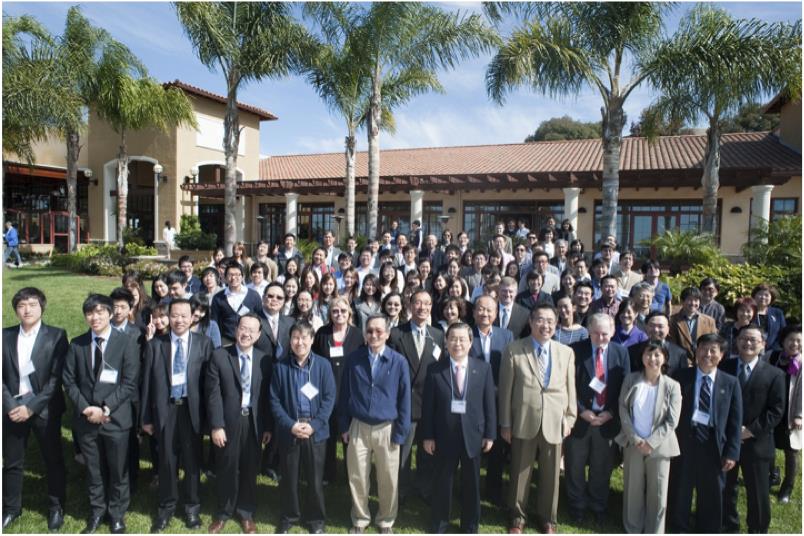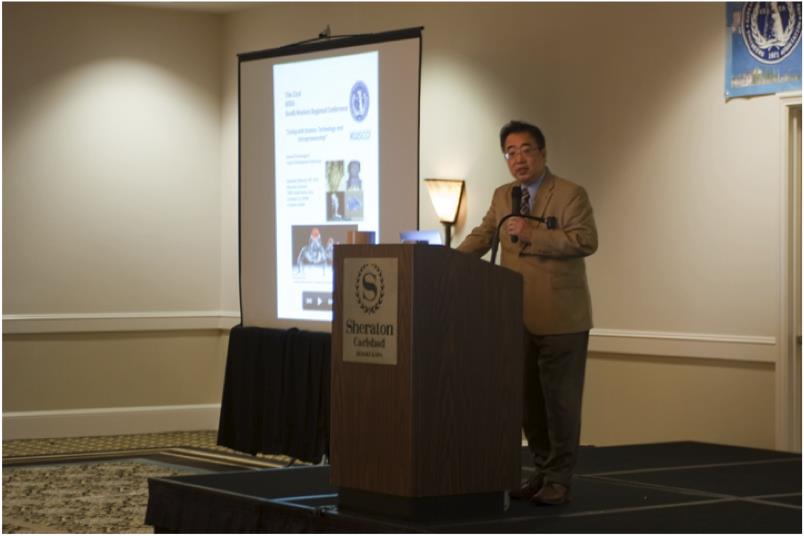

KUSCO is pleased to announce our support for the 23rd South Western Regional Conference held on February 16th (Saturday) 2013 at the beautiful Carlsbad Sheraton hotel. The event was a very meaningful because the event was the first joint conference between the San Diego chapter and Southern California chapter. Many important figures of Korean community came to congratulate the event including Consul General Young Sung Shin, KSEA president Hyungmin Michael Chung, Mayor of Gumi City, YooChin Nam and KITECH USA. The theme of SWRC was “Living with Science and Technology” and plenary speakers delivered the importance of theme for the young generation scientists and engineers for their future career. The first plenary speaker was Dr. Wayne Miller, currently Vice Director at Center for environmental research and technology at the University of California, Riverside is the expert in the fields of fuel efficiency and impact on environment. He shared the life long lessons, “the importance of identifying partners and being persistent” from his career with young generation audience. The second plenary speaker, Dr. Jae Hoon Kim spoke about innovative current and futuristic technologies.
“Promise of Stem Cells” was a topic of Session I Bio track, organized by Dr. Jung Joo Hwang at UCSD & Jae Myoung Suh at Salk Institute. Professor Jeannie Loring from the Scripps Research Institute was a keynote speaker. Dr. Loring gave a general overview of the state of stem cell research and how her group has contributed to establish critical molecular standards to understand and define exactly what a pluripotent stem cell is. Dr. Chang-sung Kim from Sanford-Burnham Medical Research Institute challenged us with newly admired technology called induced pluripotent stem cell generation. He walked through how we can envision the future human health care and disease treatment with stem cell technology. Although he mainly focused on ARVD cardiac diseases modeling, we are quite sure that his findings and contribution in science community will harness the cure of other fatal disease in human. Dr. Yongsung Hwang from UCSD introduced how to engineer hydrogel-based artificial extracellular matrix to create synthetic matrix with potential to regulate matrix rigidity. Dr. Yoonsung Lee from UCSD showed very beautiful picture and movie regarding how blood cell origins form and function using animal model system. Final speaker of the session I was Eric Furman from Knobbe Martens. Dr. Furman provided an excellent historical overview of intellectual property law and how it co-evolves with the advances in science and technology and how scientists can protect discoveries made at the bench.
Session II Bio track, titled “Horizon of Molecular and Cell Biology,” was organized by Dr. Jung Joo Hwang at UCSD & Dr. Chungsung Kim at Sanford-Burnham Medical Research Institute. Professor Ohyun Kwon from UCLA was a keynote speaker. Dr. Ohyun Kwon showed excellent works in her own lab during last decade regarding novel approaches to find better synthesis platform for biologically functional chemical drug repertoire. Professor William Song at UCSD introduced next-generation Dynamic Modulated Brachytherapy (DMBT) for Cancer Treatment. Using a robotic applicator, he emphasized possible treatment option with limited side-effect to treat various cancers. Professor Young Jun Kang from the Scripps Research Institute gave lecture on body’s immune response upon inflammation followed by anti-inflammatory drugs introduction. Final speaker was Jae Myoung Suh from Salk Institute. Dr. Suh presented his recent discovery of a novel and unexpected link between the adipocyte master regulator PPARgamma (PPARG) and fibroblast growth factor 1(FGF1) in regulating adipose tissue homeostasis.
The computer science session was organized by Dr. Suejeong Huh with the theme of “Computer aided society”. The keynote speaker professor Chang-hyunJo presented “Can Agile Processes Make Your Life Agile?”. The Software Process of Rigid and Agile has been presented to discuss which is better process and how the process can be improved. The second speaker, Professor Arthur H Lee spoke DBMS perspective of Data Life Cycle has been presented and compared Oracle and Teradata approach. “3D Face from Images” was presented by Dr. Jongmoo Choi. In his presentation, 3D Face reconstruction from images using morphing has been discussed. Dr. Sun Hyoung Han presented “Discriminant Saliency Network for Object Recognition”. Dr. Han discussed hierarchial Discriminant Saliency Network. The final speaker Dr. John Lee presented machine learning and data mining that were used in auditing.
The forum “From R&D to Entrepreneurship” chaired by Dr. Sung Hwan Cho from NanoCellect Biomedical. Brian Chung, CEO of Interactive Display Solutions gave an introduction of INKE (International Korean Entrepreneurs) and other local association such as KASE or K-group in northern California area. Inseop Jeong introduced his own consulting company, NBIT Research, that provides consulting services in the field of Nano, Bio, Information Technologies for start up companies in Korea. Dr. Jeong showed several useful market analysis tools and explained how it can lead to a useful report that a company can refer to when making a important decision, such as if the company wants to expand to the new area. Sung Hwan Cho gave a talk about his start up company: how it was founded, how the company has raised multi million dollars by Small Business Innovative Research (SBIR) program from the US government. Yougmin Lee introduced a new exciting event YG and Dr. Bo Ryu are trying to hold at UKC2013 this August.
The Electrical Engineering session was chaired by Dr. Youngin Oh. The keynote speaker, Professor Sang Hee Kim from Kumoh national institute of Technology introduced new project of Biomedical & IT convergence that will be carried on next five years. The second speaker was Han Seung Kim from Qualcomm, and discussed how CAD tools can play a role in mitigating from challenges of various aspects of semiconductor manufacturing process. The third speaker, Dong Hyup Shin discussed his PhD thesis work, phased array receiver for use of portable device to minimize the power consumption without significantly sacrificing performance. The technique of his research is used to turn the switch on/off to minimize the power consumption with optimized channel to be considered to substantiate array performance. The last speaker, Dr. Jong Wook, Woo from Calstate, Los Angeles addressed the importance of dealing with big data. Because of the amount of data in our world is exploding, and analyzing large data sets (more than tera bytes) and increasingly fluid, the traditional database like relational database is not useable and Big Data is quickly becoming a key foundation of productivity, growth, and innovation./p>
Track C covered diverse issues related to environmental clean up, emerging contaminants, drinking water treatment in southern California. One of presentation was a case study, “removal of naturally occurring uranium for the Campo Hills water system”. Campo is a small community located in southeast San Diego County, 1 mile from US-Mexico border. To provide potable water to the community, County of San Diego installed three (3) groundwater wells. Groundwater in the area is under the influence of naturally occurring uranium that is to be removed before delivery. The presentation included the site information, water quality, water treatment processes, and distribution. Another presentation was about national mussel watch monitoring of the California Coast. In 2009, a pilot project initiated within NOAA’s Mussel Watch Program monitored contaminants of emerging concern (CECs) in California coastal waters. The CECs were: pharmaceuticals and personal care products (PPCP), polybrominated diphenyl ethers (PBDE), current use pesticides (CUP), perfluorinated compounds (PFC) hexabromocyclododecane (HBCD) and alternate flame retardants, and alkylphenols (AP). Results from this project will be used to suggest analytes and station locations in future Mussel Watch surveys and California-specific monitoring projects. In addition, sustainability in development was introduced as a separate presentation. Examples of how to imply sustainability in urban development management were introduced. Current perspectives on environmental site clean up in California were introduced. Strategies to enter US civil engineering market for Korean companies were introduced and discussed in the session.
The YG session invited John Lee, YG director and Kookjoon An to hear why building leadership is important. They discussed two different aspects of how to build a good leadership in an organization. The session provided free discussion on the future career selection.
This year organizing two chapters made an MOU with Gumi city and promised to build a productive relationship. The successful event was closed at the dinner for session chairs, speakers and volunteers. We all were looking forward to having a more meaningful SWRC next year in the Los Angeles area.


